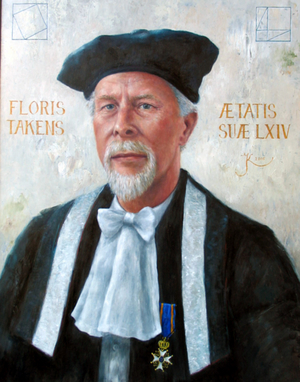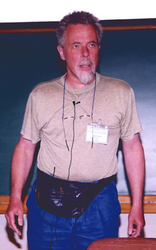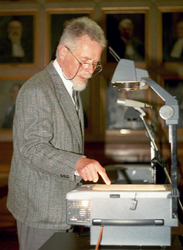 |
Knight Floris Takens
by Bernd Krauskopf
University of Bristol, UK |
The University of Groningen's Academy portait of
Floris Takens by Jacqueline Kasemier. |
In a special ceremony at the University of Groningen on 11 November
2005 a portrait of Floris Takens was unveiled. The portrait was
commissioned by the University of Groningen as part of its series of
`Academy Portraits' of distinguished members of the
University. On initiative of Henk Broer, and with financial
contributions from the former PhD students of Floris and the
Institute for
Mathematics and Computer Science at Groningen, Dutch artist
Jacqueline Kasemier painted Floris.
At the same ceremony, and as a surprise to Floris, he was made a
Ridder in de Orde van de Nederlandse Leeuw (Knight in the Order of the
Dutch Lion) by her Majesty Queen Beatrix of the Netherlands for his
important contributions to the scientific life of the Netherlands and
beyond. This official part of the ceremony was performed by the mayor
of Bedum, Floris's home town near Groningen.
Floris Takens has been professor of mathematics at the University of
Groningen from 1972 until his retirement in the year 1999, but remains
active in research. Floris is one of the founding fathers of dynamical
systems theory, and arguably most famous far beyond the dynamical
systems community for two papers:
On the nature of turbulence with
David Ruelle, and `Detecting strange attractors in turbulence' [in
D. A. Rand & L.-S. Young (Eds) Dynamical systems and turbulence,
Warwick 1980, LNM 898, pp. 366-381, Springer-Verlag, 1981].
By the time of this interview in December 2005 Floris's portrait is
in its final place on the wall of the Faculty Room in the main
building of the University of Groningen --- complete with the duly
added cross signifying his Knighthood.
You obtained a PhD in differential topology with N.H. Kuiper in
Amsterdam in 1969. How did you get into dynamical systems after
that?
| My thesis was indeed in differential topology ---
relating the minimal possible number of critical points of a function
on a compact manifold to invariants from algebraic topology. Around
that time and before, people working in differential topology started
to move to dynamical systems. |
| Steve Smale initiated this move and
his famous paper `Differentiable dynamical systems' of 1967
[Bull. Am. Math. Soc. 73: 747-817], in which he exposed
his program, made me decide to follow his line. After my PhD I got a
grant from ZWO, the Dutch funding agency at the time, to spend a year
at the Institute des
Hautes Études Scientifiques (I.H.E.S.). Other
people that year at I.H.E.S. included Steve Smale, Charles Pugh, Mike
Shub, Christopher Zeeman, and the permanent members David Ruelle and
René Thom. I started working on various problems in dynamical
systems. |
 |
| Floris Takens early
in his career |
| The paper `On the nature of
turbulence' with David Ruelle was a direct outcome of my time at
I.H.E.S.. René Thom expressed the opinion that the Hopf
bifurcation is important, but that it was not known well enough. He
asked me to lecture on it in his seminar, and to explain it in a more
geometric way. Afterwards David Ruelle explained to me how Hopf
thought this bifurcation was related to turbulence. The result of our
paper could be summarized as `Smale plus Hopf implies turbulence'. The
paper was initially rejected by the Archive of Rational Mechanics and
Analysis and then accepted by the Communications of Mathematical
Physics. It may have helped that David Ruelle was an editor of the
latter journal. |
How did the embedding theorem come about?
The first experimental indications of the route to turbulence as
suggested by David Ruelle and myself were published by Gollub and
Swinney in 1975 in experimental spectra in Taylor-Couette flow,
[Onset of turbulence in a rotating fluid, Phys
Rev. Lett. 35: 927-930 (1975); see also I. Stewart,
Does God play dice? p. 175-182]. The question arose
how one can detect turbulence in time series data. Interestingly, my
paper was published in the proceedings of a conference in Warwick in
1980 that appeared as Springer Lecture Notes 898. Times have
changed: today only journal publications count and the quality of
proceedings has gone down to the point that they have often only pulp
value.
How did the area of dynamical systems change over the
years?
| In the
beginning applications did not play a role at all. For example,
Smale's programme concerning structural stability was very much pure
mathematics, as it was inspired by the wish to `classify' all generic
dynamical systems. Today the situation is very different with many
areas of application. One reason for this development is that
dynamical systems theory does give insight. But the real change came
with the availability of numerical simulations. Without them there
would be no, or only minimal, connections between dynamical systems
theory and applications. In the analysis of concrete models theory
plays a role, but the key is the close contact between theory and
practical questions. |
|
 |
|
Where do you see the challenges in the future?
|
Floris Takens at IMPA on the occasion of Jacob Palis's 60th birthday |
Low-dimensional models are often not entirely realistic. For
example, modelling the Gulf stream demands extremely large models. The
practical value of smaller models is often disputed. One main problem
is to avoid getting lost in the parameter space of realistic models. A
five-dimensional parameter space is already quite a challenge. The key
is to find better models. This is mainly a questions of better
measurements, the development of mathematical models by experts in
both mathematics and the applying discipline, and improved numerical
methods. I do not see this as a task for dynamical systems theory in
the first instance.
This sounds a bit negative, what should be done?
The key is a close collaboration with experts in other fields. In
my experience it takes years to develop mutual trust, which is a
problem in our publication culture. Researchers need to get results
fast and do not really feel they should think about a problem for a
long time. This is counterproductive for the introduction of new
mathematical ideas into other fields of science, because it requires
time to actually learn something new. Similarly, a mathematician
working with colleagues in another field must also learn a lot
first.
What is your view of how dynamical systems, and mathematics more
generally, has changed over the years?
Today there are many more professions where mathematics is
applied, for example, statistics, logistics and numerical analysis.
On the other hand, the number of mathematics students in the
Netherlands is practically the same as when I studied in the early
1960s. So mathematics is not attracting the brightest minds. In my
view this is because of the secondary school curriculum. Critical and
careful thinking is not being taught at school any longer. Many
school children get a wrong idea of mathematics and are put off it for
life. This is not the case, for example, in astronomy because it is not
taught at school. There is a danger that we will soon not
have enough technically educated people. More generally, the status of
scientists has gone down dramatically. I remember an American poll in the
fifties into the status of different professions. Nuclear
scientist came out top, before President of the United States on
second place! The result will be different today.
As head of the Mathematics Section of the
Royal Dutch Academy of
Sciences you must have some idea of what to do about
this...
It is very difficult to change the situation as it is the
expression of a wider social phenomenon. I am afraid that `the quay
will have to stop the ship', to use a Dutch saying. We will soon have
a real problem because a lot of school leavers cannot actually read,
write and calculate properly. This while the Netherlands see themselves
as a `knowledge economy'. One main problem is that the number of
administrative and managerial staff, especially in schools, has
increased enormously over the years. All these people have ideas of
how to change something, but more to make themselves important rather
than to improve anything.
What about attempts to improve the image of mathematics in the
wider public?
 |
There are many examples of people and books that talk in an
inspiring way about things that people do not understand, such as
string theory or black holes. This is great, but there is nobody who
talks about the mathematics all around us. People think it is boring
to design a good national schedule of train times, yet there is
fascinating mathematics in this. In terms of dynamical systems,
everybody will have seen by now the fractal model of a fern leaf, but
this is about as far as it goes. No biologist will think a `fractal
tree' is like a real tree. Only if the general public is aware of the
power and beauty of mathematics and science will these subjects become
more attracting again. |
|
Why did you retire early at the age of 59 in
1999?
It is a big advantage that I have no administrative duties any
longer. I also had the impression that the quality and eagerness of
the students did not exactly increase. I enjoy being research active
on a more relaxed level.
|
|
 |
| Floris Takens at his 60th birthday celebration; June 2001, University of Groningen (notice the other Academy portraits in the background). Photograph by Florian Wagener. |
What does it feel like to be a Knight and have your own portrait
on the wall of the Faculty room?
I think it is an excellent initiative that the University of
Groningen has revived an old tradition and has been commissioning new
Academy Portraits in the last few years. It allows for an altogether
different way of contact between scientists and artists. It is much
more personal than the present regulation that 1% of the total cost of
each new building must be used to commission works of art. As far as
my Knighthood is concerned, I am very grateful for the recognition. I
know that both the portrait and the Knighthood required a lot of work
and support from my peers. I am especially grateful to my long-term
collaborator Henk Broer for his initiative.